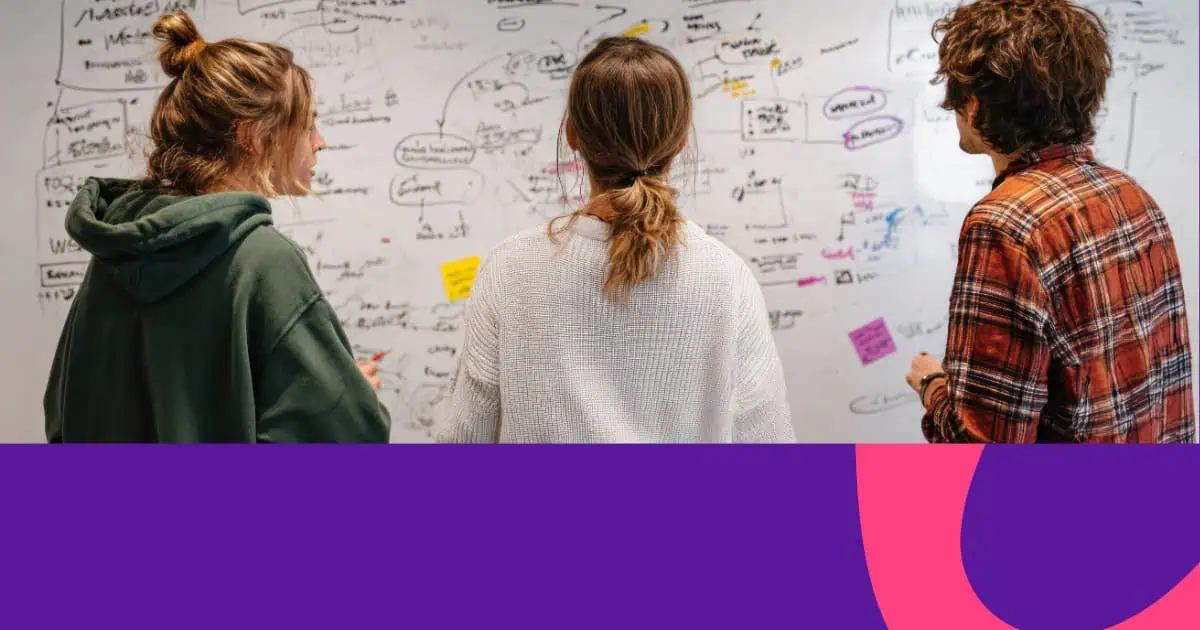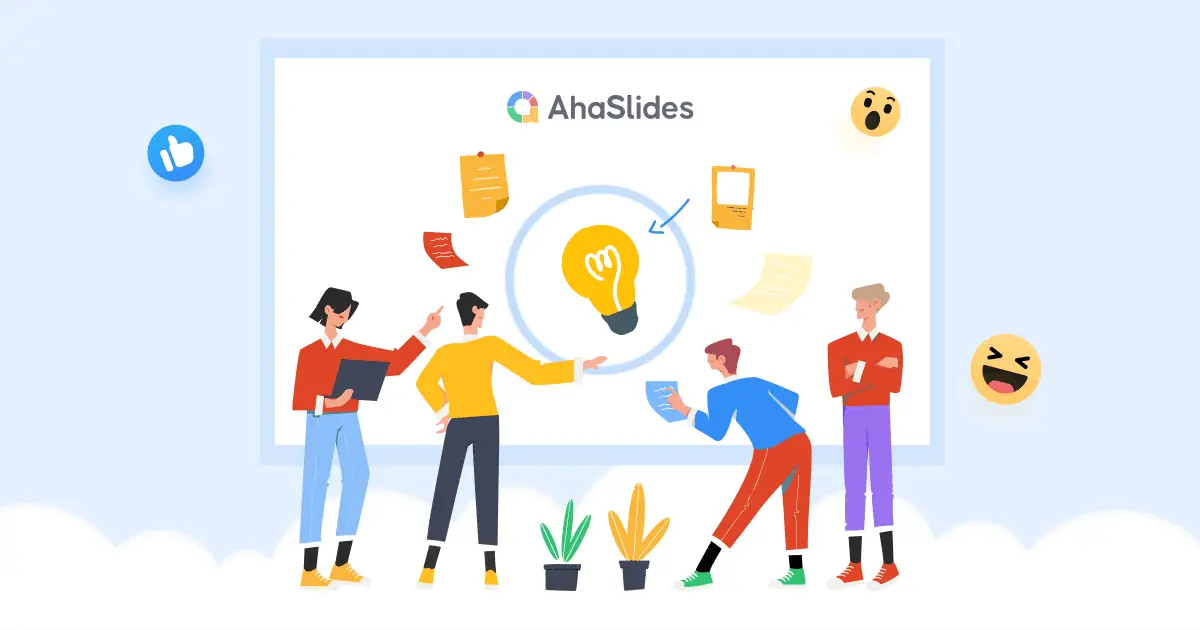Brainstorming is one of the most valuable skills for trainers, HR professionals, event organisers, and team leaders. Whether you're developing training content, solving workplace challenges, planning corporate events, or facilitating team-building sessions, effective brainstorming techniques can transform how you generate ideas and make decisions.
Research shows that teams using structured brainstorming methods generate up to 50% more creative solutions than unstructured approaches. However, many professionals struggle with brainstorming sessions that feel unproductive, dominated by a few voices, or fail to deliver actionable results.
This comprehensive guide walks you through proven brainstorming techniques, best practices, and practical strategies used by professional facilitators. You'll discover how to structure effective brainstorming sessions, learn when to use different techniques, and gain insights into overcoming common challenges that prevent teams from reaching their creative potential.

Table of Contents
- What is brainstorming?
- 5 golden rules of brainstorm
- 10 proven brainstorming techniques for professional contexts
- Technique 1: Reverse brainstorming
- Technique 2: Virtual brainstorming
- Technique 3: Associative brainstorming
- Technique 4: Brainwriting
- Technique 5: SWOT analysis
- Technique 6: Six thinking hats
- Technique 7: Nominal group technique
- Technique 8: Projective techniques
- Technique 9: Affinity diagram
- Technique 10: Mind mapping
What is brainstorming and why does it matter?
Brainstorming is a structured creative process for generating a large number of ideas or solutions to a specific problem or topic. The technique encourages free thinking, suspends judgment during idea generation, and creates an environment where unconventional ideas can emerge and be explored.
The value of effective brainstorming
For professional contexts, brainstorming delivers significant benefits:
- Generates diverse perspectives - Multiple viewpoints lead to more comprehensive solutions
- Encourages participation - Structured approaches ensure all voices are heard
- Breaks through mental blocks - Different techniques help overcome creative barriers
- Builds team cohesion - Collaborative idea generation strengthens working relationships
- Improves decision quality - More options lead to better-informed choices
- Accelerates problem-solving - Structured processes deliver results faster
- Enhances innovation - Creative techniques uncover unexpected solutions
When to use brainstorming
Brainstorming is particularly effective for:
- Training content development - Generating engaging activities and learning materials
- Problem-solving workshops - Finding solutions to workplace challenges
- Product or service development - Creating new offerings or improvements
- Event planning - Developing themes, activities, and engagement strategies
- Team-building activities - Facilitating collaboration and communication
- Strategic planning - Exploring opportunities and potential approaches
- Process improvement - Identifying ways to enhance workflows and efficiency
5 golden rules of brainstorm
The 5 golden rules of effective brainstorming
Successful brainstorming sessions follow fundamental principles that create an environment conducive to creative thinking and idea generation.
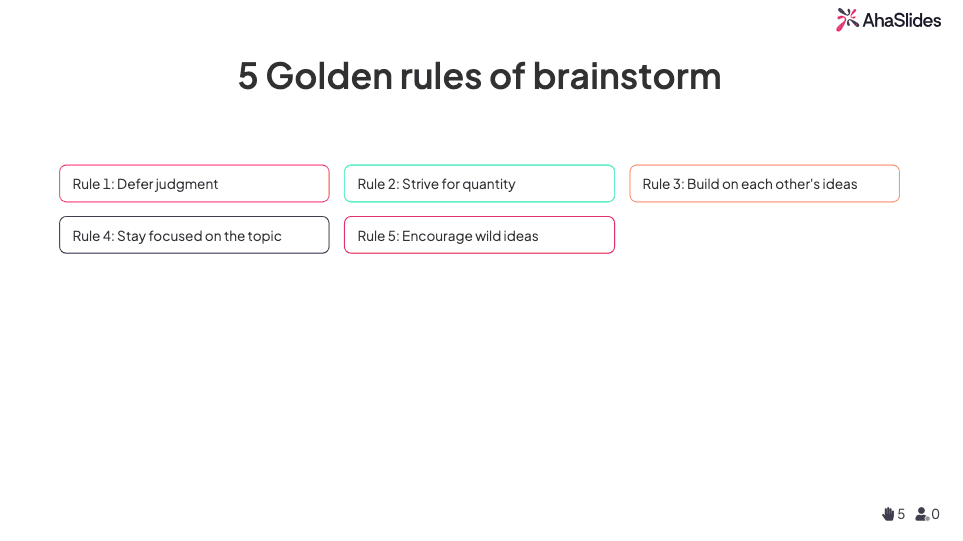
Rule 1: Defer judgment
What it means: Suspend all criticism and evaluation during the idea generation phase. No idea should be dismissed, criticised, or evaluated until after the brainstorming session.
Why it matters: Judgment kills creativity. When participants fear criticism, they self-censor and hold back potentially valuable ideas. Creating a judgment-free zone encourages risk-taking and unconventional thinking.
How to implement:
- Establish ground rules at the start of the session
- Remind participants that evaluation comes later
- Use a "parking lot" for ideas that seem off-topic but might be valuable
- Encourage the facilitator to gently redirect judgmental comments
Rule 2: Strive for quantity
What it means: Focus on generating as many ideas as possible, without worrying about quality or feasibility during the initial phase.
What it means: Quantity leads to quality. Research shows that the most innovative solutions often appear after generating many initial ideas. The goal is to exhaust obvious solutions and push into creative territory.
How to implement:
- Set specific quantity goals (e.g., "Let's generate 50 ideas in 10 minutes")
- Use timers to create urgency and momentum
- Encourage rapid-fire idea generation
- Remind participants that every idea counts, no matter how simple
Rule 3: Build on each other's ideas
What it means: Encourage participants to listen to others' ideas and expand, combine, or modify them to create new possibilities.
Why it matters: Collaboration multiplies creativity. Building on ideas creates synergy where the whole becomes greater than the sum of parts. One person's incomplete thought becomes another's breakthrough solution.
How to implement:
- Display all ideas visibly so everyone can see them
- Ask "How can we build on this?" regularly
- Use phrases like "Yes, and..." instead of "Yes, but..."
- Encourage participants to combine multiple ideas
Rule 4: Stay focused on the topic
What it means: Ensure all ideas generated are relevant to the specific problem or topic being addressed, whilst still allowing creative exploration.
Why it matters: Focus prevents wasted time and ensures productive sessions. Whilst creativity is encouraged, maintaining relevance ensures ideas can actually be applied to the challenge at hand.
How to implement:
- Clearly state the problem or topic at the beginning
- Write the focus question or challenge visibly
- Gently redirect when ideas drift too far off-topic
- Use the "parking lot" for interesting but tangential ideas
Rule 5: Encourage wild ideas
What it means: Actively welcome unconventional, seemingly impractical, or "out-of-the-box" ideas without immediate concern for feasibility.
Why it matters: Wild ideas often contain the seeds of breakthrough solutions. What seems impossible initially might reveal a practical approach when explored further. These ideas also inspire others to think more creatively.
How to implement:
Remind participants that wild ideas can be refined into practical solutions
Explicitly invite "impossible" or "crazy" ideas
Celebrate the most unconventional suggestions
Use prompts like "What if money were no object?" or "What would we do if we had unlimited resources?"
10 proven brainstorming techniques for professional contexts
Different brainstorming techniques suit different situations, group sizes, and objectives. Understanding when and how to use each technique maximises your chances of generating valuable ideas.
Technique 1: Reverse brainstorming
What it is: A problem-solving approach that involves generating ideas for how to create or worsen a problem, then reversing those ideas to find solutions.
When to use:
- When traditional approaches aren't working
- To overcome cognitive biases or entrenched thinking
- When you need to identify root causes
- To challenge assumptions about a problem
How it works:
- Clearly define the problem you want to solve
- Reverse the problem: "How can we make this problem worse?"
- Generate ideas for creating the problem
- Reverse each idea to find potential solutions
- Evaluate and refine the reversed solutions
Example: If the problem is "low employee engagement," reverse brainstorming might generate ideas like "make meetings longer and more boring" or "never acknowledge contributions." Reversing these leads to solutions like "keep meetings concise and interactive" or "regularly recognise achievements."
Benefits:
- Breaks through mental blocks
- Reveals underlying assumptions
- Identifies root causes
- Encourages creative problem reframing
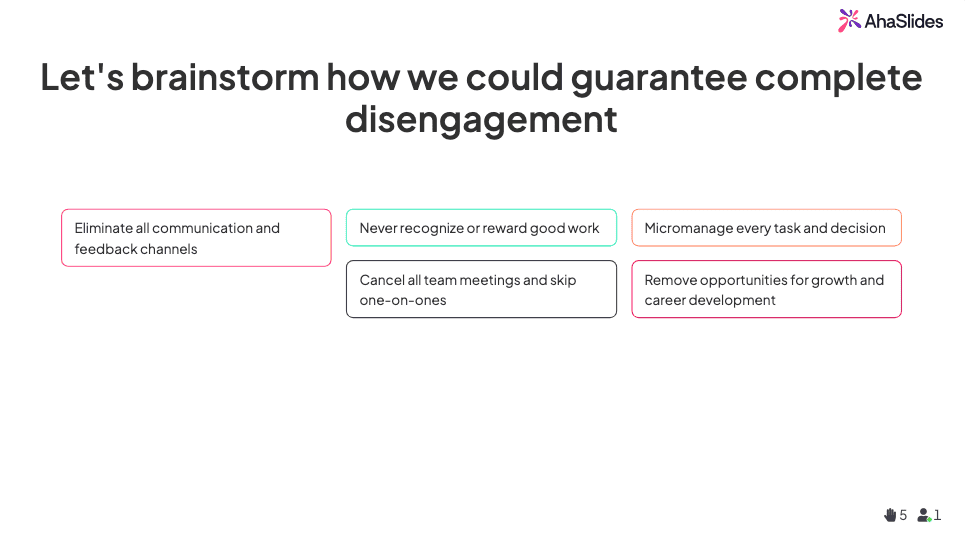
Technique 2: Virtual brainstorming
What it is: Collaborative idea generation that takes place online using digital tools, video conferencing, or asynchronous collaboration platforms.
When to use:
- With remote or distributed teams
- When scheduling conflicts prevent in-person meetings
- For teams across different time zones
- When you want to capture ideas asynchronously
- To reduce travel costs and increase participation
How it works:
- Choose appropriate digital tools (AhaSlides, Miro, Mural, etc.)
- Set up virtual collaboration space
- Provide clear instructions and access links
- Facilitate real-time or asynchronous participation
- Use interactive features like word clouds, polls, and idea boards
- Synthesise and organise ideas after the session
Best practices:
- Use tools that allow anonymous participation to reduce social pressure
- Provide clear instructions for using the technology
- Set time limits to maintain focus
AhaSlides for virtual brainstorming:
AhaSlides offers interactive brainstorming features specifically designed for professional contexts:
- Brainstorming slides - Participants submit ideas anonymously via smartphones
- Word clouds - Visualise common themes as they emerge
- Real-time collaboration - See ideas appear live during sessions
- Voting and prioritisation - Rank ideas to identify top priorities
- Integration with PowerPoint - Works seamlessly within presentations
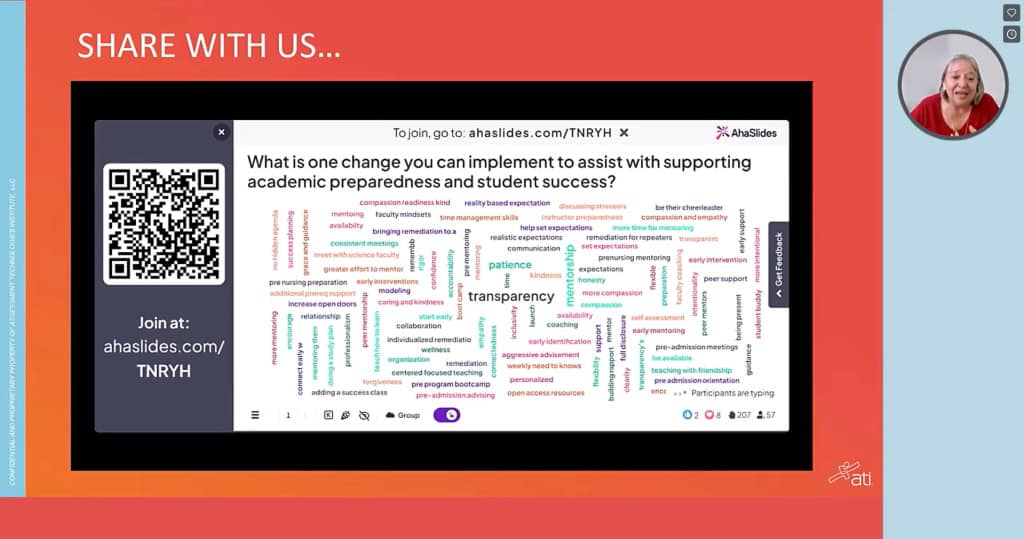
Technique 3: Associative brainstorming
What it is: A technique that generates ideas by making connections between seemingly unrelated concepts, using free association to spark creative thinking.
When to use:
- When you need fresh perspectives on a familiar topic
- To break out of conventional thinking patterns
- For creative projects requiring innovation
- When initial ideas feel too predictable
- To explore unexpected connections
How it works:
- Start with a central concept or problem
- Generate the first word or idea that comes to mind
- Use that word to generate the next association
- Continue the chain of associations
- Look for connections back to the original problem
- Develop ideas from interesting associations
Example: Starting with "employee training," associations might flow: training → learning → growth → plants → garden → cultivation → development. This chain might inspire ideas about "cultivating skills" or "creating growth environments."
Benefits:
- Reveals unexpected connections
- Breaks through mental ruts
- Encourages creative thinking
- Generates unique perspectives
Technique 4: Brainwriting
What it is: A structured technique where participants write down ideas individually before sharing them with the group, ensuring all voices are heard equally.
When to use:
- With groups where some members dominate discussions
- When you want to reduce social pressure
- For introverted team members who prefer written communication
- To ensure equal participation
- When you need time for reflection before sharing
How it works:
- Provide each participant with paper or digital document
- Pose the problem or question clearly
- Set a time limit (typically 5-10 minutes)
- Participants write ideas individually without discussion
- Collect all written ideas
- Share ideas with the group (anonymously or attributed)
- Discuss, combine, and develop ideas further
Variations:
- Round-robin brainwriting - Pass papers around, each person adds to previous ideas
- 6-3-5 method - 6 people, 3 ideas each, 5 rounds of building on previous ideas
- Electronic brainwriting - Use digital tools for remote or hybrid sessions
Benefits:
- Ensures equal participation
- Reduces influence of dominant personalities
- Allows time for reflection
- Captures ideas that might be lost in verbal discussions
- Works well for introverted participants
Technique 5: SWOT analysis
What it is: A structured framework for evaluating ideas, projects, or strategies by analysing Strengths, Weaknesses, Opportunities, and Threats.
When to use:
- For strategic planning sessions
- When evaluating multiple options
- To assess feasibility of ideas
- Before making significant decisions
- To identify risks and opportunities
How it works:
- Define the idea, project, or strategy to analyse
- Create a four-quadrant framework (Strengths, Weaknesses, Opportunities, Threats)
- Brainstorm items for each quadrant:
- Strengths - Internal positive factors
- Weaknesses - Internal negative factors
- Opportunities - External positive factors
- Threats - External negative factors
- Prioritise items in each quadrant
- Develop strategies based on the analysis
Best practices:
- Be specific and evidence-based
- Consider both short-term and long-term factors
- Involve diverse perspectives
- Use SWOT to inform decision-making, not replace it
- Follow up with action planning
Benefits:
- Provides comprehensive view of situation
- Identifies both internal and external factors
- Helps prioritise actions
- Supports strategic decision-making
- Creates shared understanding
Technique 6: Six thinking hats
What it is: A technique developed by Edward de Bono that uses six different thinking perspectives, represented by coloured hats, to explore problems from multiple angles.
When to use:
- For complex problems requiring multiple perspectives
- When group discussions become one-sided
- To ensure comprehensive analysis
- When you need structured thinking process
- For decision-making that requires thorough evaluation
How it works:
- Introduce the six thinking perspectives:
- White Hat - Facts and data (objective information)
- Red Hat - Emotions and feelings (intuitive responses)
- Black Hat - Critical thinking (risks and problems)
- Yellow Hat - Optimism (benefits and opportunities)
- Green Hat - Creativity (new ideas and alternatives)
- Blue Hat - Process control (facilitation and organisation)
- Assign hats to participants or rotate through perspectives
- Explore the problem from each perspective systematically
- Synthesise insights from all perspectives
- Make informed decisions based on comprehensive analysis
Benefits:
- Ensures multiple perspectives are considered
- Prevents one-sided discussions
- Structures thinking process
- Separates different types of thinking
- Improves decision quality
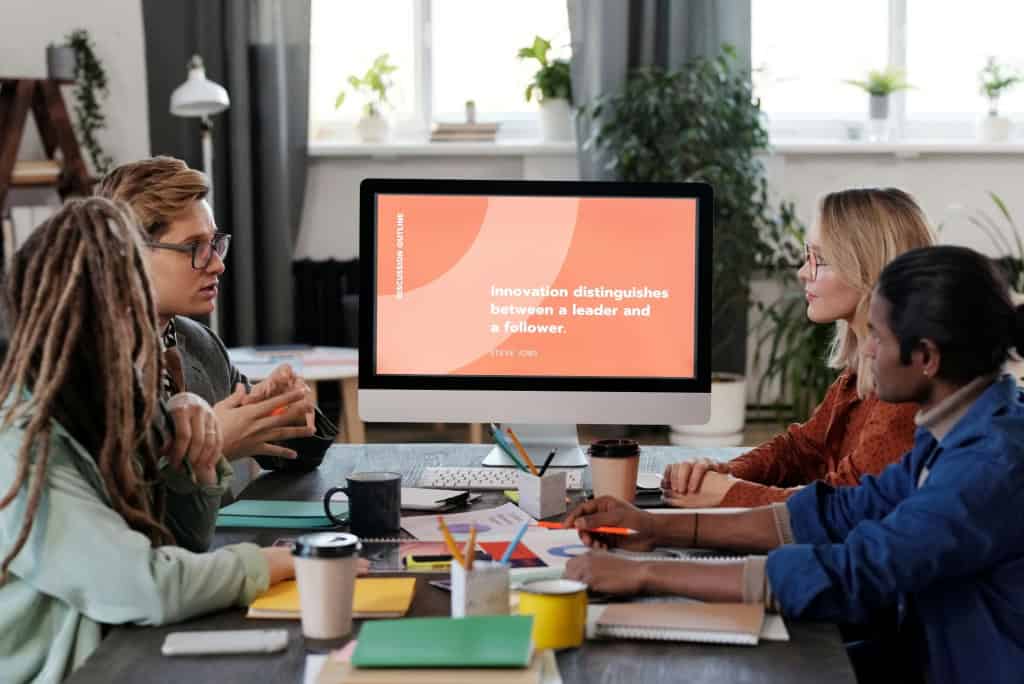
Technique 7: Nominal group technique
What it is: A structured method that combines individual idea generation with group discussion and prioritisation, ensuring all participants contribute equally.
When to use:
- When you need to prioritise ideas
- With groups where some members dominate
- For important decisions requiring consensus
- When you want structured decision-making
- To ensure all voices are heard
How it works:
- Silent idea generation - Participants write ideas individually (5-10 minutes)
- Round-robin sharing - Each participant shares one idea, round continues until all ideas are shared
- Clarification - Group discusses and clarifies ideas without evaluation
- Individual ranking - Each participant privately ranks or votes on ideas
- Group prioritisation - Combine individual rankings to identify top priorities
- Discussion and decision - Discuss top-ranked ideas and make decisions
Benefits:
- Ensures equal participation
- Reduces influence of dominant personalities
- Combines individual and group thinking
- Provides structured decision-making process
- Creates buy-in through participation
Technique 8: Projective techniques
What it is: Methods that use abstract stimuli (words, images, scenarios) to elicit subconscious ideas, feelings, and associations related to a problem.
When to use:
- For creative projects requiring deep insights
- When exploring consumer or user attitudes
- To uncover hidden motivations or concerns
- For marketing and product development
- When traditional approaches yield surface-level ideas
Common projective techniques:
Word association:
- Present a word related to the problem
- Participants share the first word that comes to mind
- Analyse patterns in associations
- Develop ideas from interesting connections
Image association:
- Show images related or unrelated to the topic
- Ask participants what the image makes them think about
- Explore connections to the problem
- Generate ideas from visual associations
Role playing:
- Participants adopt different personas or perspectives
- Explore the problem from those viewpoints
- Generate ideas based on different roles
- Uncover insights from alternative perspectives
Storytelling:
- Ask participants to tell stories related to the problem
- Analyse themes and patterns in stories
- Extract ideas from narrative elements
- Use stories to inspire solutions
Sentence completion:
- Provide incomplete sentences related to the problem
- Participants complete sentences
- Analyse responses for insights
- Develop ideas from completed thoughts
Benefits:
- Reveals subconscious thoughts and feelings
- Uncovers hidden motivations
- Encourages creative thinking
- Provides rich qualitative insights
- Generates unexpected ideas
Technique 9: Affinity diagram
What it is: A tool for organising large amounts of information into related groups or themes, helping identify patterns and relationships among ideas.
When to use:
- After generating many ideas that need organisation
- To identify themes and patterns
- When synthesising complex information
- For problem-solving with multiple factors
- To build consensus around categorisation
How it works:
- Generate ideas using any brainstorming technique
- Write each idea on a separate card or sticky note
- Display all ideas visibly
- Participants silently group related ideas together
- Create category labels for each group
- Discuss and refine groupings
- Prioritise categories or ideas within categories
Best practices:
- Let patterns emerge naturally rather than forcing categories
- Use clear, descriptive category names
- Allow regrouping if needed
- Discuss disagreements about categorisation
- Use categories to identify themes and priorities
Benefits:
- Organises large amounts of information
- Reveals patterns and relationships
- Promotes collaboration and consensus
- Creates visual representation of ideas
- Identifies areas for further investigation

Technique 10: Mind mapping
What it is: A visual technique that organises ideas around a central concept, using branches to show relationships and connections between ideas.
When to use:
- For organising complex information
- When exploring relationships between ideas
- For planning projects or content
- To visualise thought processes
- When you need a flexible, non-linear approach
How it works:
- Write the central topic or problem in the centre
- Draw branches for major themes or categories
- Add sub-branches for related ideas
- Continue branching to explore details
- Use colours, images, and symbols to enhance visualisation
- Review and refine the map
- Extract ideas and action items from the map
Best practices:
- Start broad and add detail progressively
- Use keywords rather than full sentences
- Make connections between branches
- Use visual elements to enhance memory
- Review and refine regularly
Benefits:
- Visual representation aids understanding
- Shows relationships between ideas
- Encourages non-linear thinking
- Enhances memory and recall
- Flexible and adaptable structure
Conclusion: The future of collaborative ideation
Brainstorming has evolved significantly from Alex Osborn's 1940s advertising agency practices. Modern facilitators face challenges our predecessors never imagined: distributed global teams, rapid technological change, unprecedented information overload, and compressed decision timelines. Yet the fundamental human need for collaborative creativity remains constant.
The most effective contemporary brainstorming doesn't choose between traditional principles and modern tools—it combines them. Timeless practices like suspending judgement, welcoming unusual ideas, and building upon contributions remain essential. But interactive technologies now operationalise these principles more effectively than verbal discussion and sticky notes alone ever could.
As a facilitator, your role transcends collecting ideas. You create conditions for psychological safety, orchestrate cognitive diversity, manage energy and engagement, and bridge creative exploration with practical implementation. The techniques in this guide provide tools for that facilitation, but they require your judgement about when to deploy them, how to adapt them to your specific context, and how to read your team's needs in the moment.
The brainstorming sessions that truly matter—those that generate genuine innovation, build team cohesion, and solve problems that matter—happen when skilled facilitators combine research-backed techniques with purposefully chosen tools that amplify human creativity rather than constraining it.
References:
- Edmondson, A. (1999). "Psychological Safety and Learning Behavior in Work Teams." Administrative Science Quarterly.
- Diehl, M., & Stroebe, W. (1987). "Productivity Loss in Brainstorming Groups." Journal of Personality and Social Psychology.
- Woolley, A. W., et al. (2010). "Evidence for a Collective Intelligence Factor in the Performance of Human Groups." Science.
- Gregersen, H. (2018). "Better Brainstorming." Harvard Business Review.
